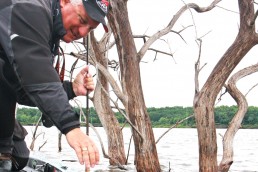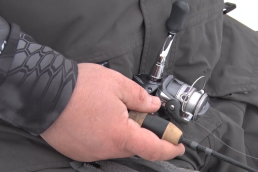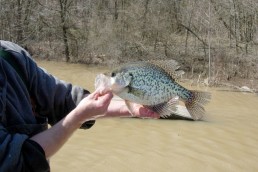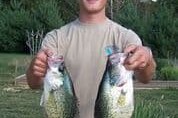Ideal Depth Crappie Fishing
SHARE THIS POST
Fishermen’s opinions vary on the ideal depth for crappie fishing. On the southern edges of the Midwest Region, lakes with soft water offer great winter opportunities. Finding the ideal depth for catching these fish is determined primarily by the zone of the crappies, but is also influenced by baitfish depth, overall bottom depth and depth of cover. A fisherman’s favorite depth zone to fish will play a role, too.
A favorite cold-water depth for catching crappies in very late winter might be 2 feet, or the 18- to 25-foot zone. The water is still cold, but occasional warm spells, mixed with longer daylight hours, can cause baitfish, and therefore crappies, to start moving up in depth. Baitfish are critical.
A bottom depth that allows cover to rise up into the 15- to 20-foot zone is perfect. A crappie looking to ambush a shad needs some cover. It’s like you deer hunting in an open field, compared to being in a tree. Cover is good.
Variables
Three-time classic champion, Travis Bunting, says he prefers 10 to 15 feet. “Fish can be caught this time of year at 30 feet. I have a friend catching them to eat from 50 feet. I’m a tournament fisherman, so I try to find fish to catch fish at 10 to 15 feet all year long because these fish are easier to keep alive, a requirement in our tournaments. Also, these fish are deep enough that they are not spooky. So, my ideal depth is 10 to 15, my buddy’s ideal depth is around 50, with most fishermen finding 15 to 25 feet being good for late-winter fish.”
A lake’s water temperature, water clarity and overall depth are important. Reelfoot Lake doesn’t have the water depth for catching crappies at 30 feet, but 16 to 18 feet is popular. Conversely, Kentucky Lake has a percentage of crappies in very deep water along channel ledges.
A fisherman with a favorite depth zone should first try to find crappies at that level. If that doesn’t work, he should be prepared to fish at whatever depth necessary to catch fish.
Electronics
Crappie fishermen have great help with today’s electronics. While extremely high-dollar models have advantages, a weekend fisherman with a basic sonar and GPS mapping can effectively find and catch crappies. The key is to learn how to properly use a unit to get the most from it. Doing so can help you locate that ideal depth for crappie fishing.
Sonar provides a visual of what is under the water including depths, cover and fish. Mapping allows drop-offs to be followed, good spots to be marked and provides safe navigation.
Catching crappies
Our first example used 18 to 25 feet as an ideal depth range. Crappies in this zone can be attacked with slow, vertical presentations including jigging, slow trolling, slip-floats and casting. Slow presentations at these depths are often best, because baits can be pinpointed on cover and held there to entice slow-bite crappie.
Are you enjoying this post?
You can be among the first to get the latest info on where to go, what to use and how to use it!
Casting can be productive and fun, but a fisherman must control the bait depth, speed and have a good “feel” of the bait to detect bottom, cover and bites. Casting from an anchored boat is best for bait control and to repeat casts to a specific spot. The right cover and a good presentation can produce great action.
Playing the conditions
Wind can be a friend or enemy. A light wind helps by making fish less spooky of boats and fishermen. However, too much wind makes boat control difficult, so good bait presentations are a problem.
Cold fronts are common in late winter and early spring. Any cold front can cause fish to become finicky, but the deeper the fish, the less a front bothers them.
Rain can be brutal for a fisherman on a cold day. Crappies may change location if there is no light penetration, but a rain usually doesn’t bother them. Sun and warm temperatures for a couple of days can warm shallow areas. A degree or two change can bring baitfish and fish into the shallows, creating great action.
Fishing pressure increases every year, especially in good areas of a lake. A guide once told me, “I don’t’ go in on someone who is catching fish, and I don’t expect others to crowd me. It’s wrong and rude. So, if I find fish on a brush pile, I don’t hesitate blocking others with my boat if they try to crowd us and catch the fish we found.”
Final Point
The final tip is from Dan Dannemueller, a tournament fisherman who travels from the south to the north each year chasing crappies. He says, “One structure I like to target is a point with a little current on it, especially if it’s in a river system or upper area of a lake. Fish will position somewhere on that point, waiting to ambush bait. Since there are a variety of depths on a point, this time of year, I’ll start a little deeper, where the current will be lightest. I’ll work up until I find the right zone, the ideal depth zone for that point. I let the fish show me the ideal depth, but if I could choose, it would be 10 feet.”
Become a MidWest Outdoors Insider here!
MWO
SHARE THIS POST
Did you enjoy this post?
You can be among the first to get the latest info on where to go, what to use and how to use it!
Tim Huffman
Tim Huffman specializes in crappie fishing, is editor for two crappie magazines, as well as writing for several others. In 2018, he published his sixth book, Limiting Out for Crappie, available at Amazon. His first article appeared in MidWest Outdoors in 1988.



